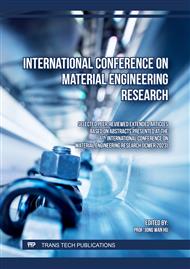[1]
J. Duer, Single use plastics are on the rise due to COVID-19 | World Economic Forum, World Economic Forum. (2020).
Google Scholar
[2]
Y. Peng, P. Wu, A.T. Schartup, Y. Zhang, Plastic waste release caused by COVID-19 and its fate in the global ocean, Proc Natl Acad Sci U S A. 118 (2021) e2111530118.
DOI: 10.1073/pnas.2111530118
Google Scholar
[3]
T.Z.Y. Abolibda, Physical and Chemical Investigations of Starch Based Bio-Plastics, (2015).
Google Scholar
[4]
L.G. Lacerda, T.A.D. Colman, T. Bauab, M.A. da Silva Carvalho Filho, I.M. Demiate, E.C. de Vasconcelos, E. Schnitzler, Thermal, structural and rheological properties of starch from avocado seeds (Persea americana, Miller) modified with standard sodium hypochlorite solutions, J Therm Anal Calorim. 115 (2014) 1893–1899.
DOI: 10.1007/s10973-013-3349-z
Google Scholar
[5]
A.J. Perea-Moreno, M.J. Aguilera-Ureña, F. Manzano-Agugliaro, Fuel properties of avocado stone, Fuel. 186 (2016) 358–364.
DOI: 10.1016/j.fuel.2016.08.101
Google Scholar
[6]
J. Yaradoddi, V. Patil, S. Ganachari, N. Banapurmath, A. Hunashyal, A. Shettar, J.S. Yaradoddi, Biodegradable Plastic Production From Fruit Waste Material and Its Sustainable Use for Green Applications, International Journal of Pharmaceutical Research & Allied Sciences. 5 (2016) 56–66.
DOI: 10.1007/978-3-319-68255-6_150
Google Scholar
[7]
A. Díaz, C. Dini, S.Z. Viña, M.A. García, Starch extraction process coupled to protein recovery from leguminous tuberous roots (Pachyrhizus ahipa), Carbohydr Polym. 152 (2016) 231–240.
DOI: 10.1016/j.carbpol.2016.07.004
Google Scholar
[8]
A. DeWolfe, How to Perform an ASTM D882 Plastic Film Tensile Strength Test - ADMET Canada, Admet. (2010).
Google Scholar
[9]
IPC, IPC-TM-650 Test Methods Manual, The Institute for Interconnecting and Packaging Electronic Circuits, (2009) 2–3.
Google Scholar
[10]
C. Torres-Leon, N. Ramirez-Guzman, L. Londono-Hernandez, G. A. Martinez-Medina, R. Diaz-Herrera, V. Navarro-Macias, O. B. Alvarez-Perez, B. Picazo, M. Villareal-Vazquez, J. Ascacio-Valdez, C. N. Aguilar, Food Waste and Byproducts: An Opportunity to Minimize Malnutrition and Hunger in Developing Countries, Frontier in Sustainable Food Systems. 2 (2018) 1-17.
DOI: 10.3389/fsufs.2018.00052
Google Scholar
[11]
H. Wu, Y. Lei, R. Zhu, M. Zhao, J. Lu, D. Xiao, C. Jiao, Z. Zhang, G. Shen, S. Li, Preparation and characterization of bioactive edible packaging films based on pomelo peel flours incorporating tea polyphenol, Food Hydrocolloids. 90 (2019) 41-49.
DOI: 10.1016/j.foodhyd.2018.12.016
Google Scholar
[12]
E. Boccalon, G. Gorrasi, Functional bioplastics from food residual: Potentiality and safety issues, Comprehensive reviews in food science and food safety. 21 (2022) 3177-3204.
DOI: 10.1111/1541-4337.12986
Google Scholar
[13]
L.T. Lim, R. Auras, M. Rubino, Processing technologies for poly(lactic acid), Progress in Polymer Science. 33 (2008) 820-852.
DOI: 10.1016/j.progpolymsci.2008.05.004
Google Scholar
[14]
R. Datta, M. Henry, Lactic acid: recent advances in product, processes and technologies – a reviw, Journal of Chemical Technology and Biotechnology. 81 (2006) 1119-1129.
DOI: 10.1002/jctb.1486
Google Scholar
[15]
E. Quejano, P. Dueñas, A. Alcayaga, A. Ayla, E. Liberato, Fabrication and Characterization of Chitosan- Coated Starch-Polyvinyl Alcohol Composite Film, 32 (2011) 23–30.
Google Scholar



